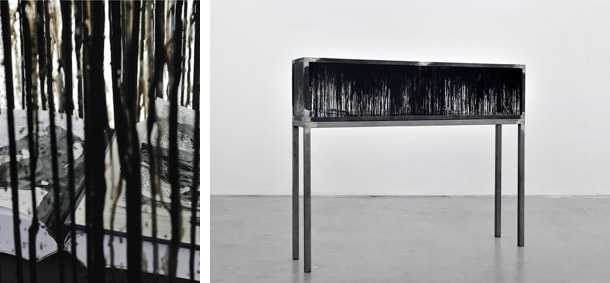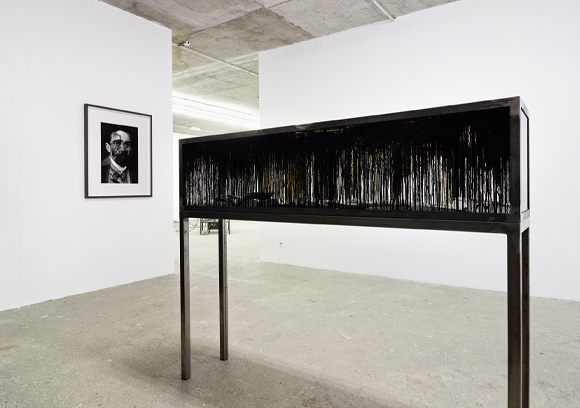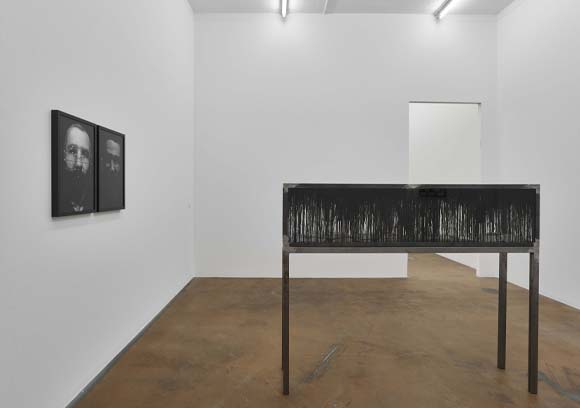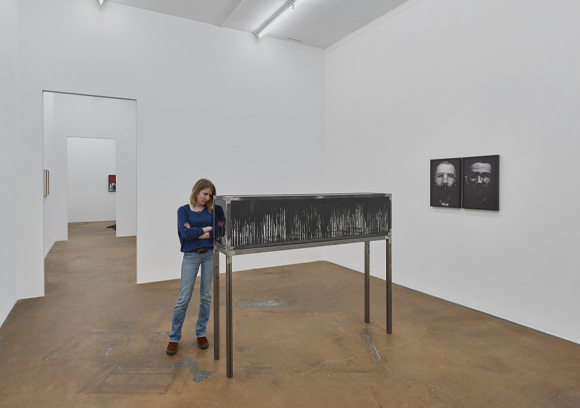| |
|
|
38.
| Divine Illusion 01 |
| |


2013, 176 x 36 x 153,5 cm, case in glass and steel, sacred books, ink.
Exhibition view from They were blind, they only saw images, Galerie Yvon Lambert, 2014, Paris.
Courtesy of the artist and Ceysson & Bénétière, Paris.
'' Here, mounir fatmi illustrates the dialectic between showing and hiding that is shared by several religions.
Like the “hidden God” of philosopher and mystic Blaise Pascal, or the God of Islam who reveals himself in the heart of believers but cannot be represented in any physical incarnation. ''
François Salmeron, Paris-Art, 2014

Divine Illusion
Exhibition view from Walking on the light, CCC - Centre de Création Contemporaine, 2014, Tours.

Divine Illusion
Exhibition view from They were blind, they only saw images, Galerie Yvon Lambert, 2014, Paris.

Divine Illusion
Exhibition view from They were blind, they only saw images, Galerie Yvon Lambert, 2014, Paris.

Divine Illusion
Exhibition view from They were blind, they only saw images, Galerie Yvon Lambert, 2014, Paris.
|
|
|
|
|
| Collection of Galila’s P.O.C, Brussels
Divine Illusion se présente comme un totem soulevé au-dessus du sol par de grands pieds. Sa vitrine tachée par de l’encre noire, tandis qu’à l’intérieur on aperçoit aussi comme tenus au secret, des livres sacrés également attaqués par l'encre noire. Ces attaques déploient la charge symbolique qui explore les paradoxes de la représentation et les formes du sacré, parfois cachés, parfois visibles.
Les formes que nous percevons sur les livres ouverts et nous amènent au test de Rorschach, une méthode psychologique qui est devenu populaire au début du XXe siècle et qui utilise des tâches ambigües et inquiétantes, dont l'association aux réalités concrètes évalue prétendument la personnalité de celui qui les interprète. Pour certains, ce sont des chevaux, pour d'autres, des anges, pour certains un cercle est un point, pour les autres, c’est l'infini. Comme le test de Rorschach, Mounir Fatmi traite de l'interprétation des textes religieux à travers multiples lectures. Il n'y a aucune vérité ou aucune vérité n’est absolue, il n’y a pas uniquement une religion, ni une seule représentation de l'image transcendante.
Ni les mots, ni les textes, ni les images du sacré ne sont des identités incontestables; ils peuvent répondre à des croyances, mais non à des faits axiomatiques. Mais Mounir Fatmi subvertit non seulement le sacré, comme son totem nous préserve de la pensée unique que le pouvoir l'emporte, mais il nous met en garde aussi contre tout endoctrinement.
Olga Sureda, juillet 2015 |
|
Divine Illusion is raised as a totem above the ground by tall feet. Its window stained by black ink, while inside is also seen as bound to secrecy, sacred books also attacked by black ink. These attacks are making the symbolic charge that explores the paradoxes of representation and forms of the sacred, sometimes hidden, sometimes visible.
The forms that we perceive on open books and bring us to the Rorschach test, a psychological method that became popular in the early twentieth century and which uses ambiguous and disturbing tasks, whose association with the concrete realities supposedly assesses personality one who interprets. For some, these are horses, for others, angels, for some a circle is a point, for others, it is the infinite. Like the Rorschach test, Mounir Fatmi deals with the interpretation of religious texts through multiple readings. There is no truth or no truth is absolute, there are not only one religion, nor a single representation of the transcendent image.
Neither words nor texts, nor the sacred images are undeniable identities; they can answer beliefs, but not axiomatic facts. But Mounir Fatmi subverts not only the sacred, like his totem preserve us from the single thought that power prevails, but it also puts us on guard against indoctrination.
Olga Sureda, july 2015 |
|
|
|